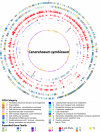Genomic analysis of the uncultivated marine crenarchaeote Cenarchaeum symbiosum
- PMID: 17114289
- PMCID: PMC1643844
- DOI: 10.1073/pnas.0608549103
Genomic analysis of the uncultivated marine crenarchaeote Cenarchaeum symbiosum
Abstract
Crenarchaeota are ubiquitous and abundant microbial constituents of soils, sediments, lakes, and ocean waters. To further describe the cosmopolitan nonthermophilic Crenarchaeota, we analyzed the genome sequence of one representative, the uncultivated sponge symbiont Cenarchaeum symbiosum. C. symbiosum genotypes coinhabiting the same host partitioned into two dominant populations, corresponding to previously described a- and b-type ribosomal RNA variants. Although they were syntenic, overlapping a- and b-type ribotype genomes harbored significant variability. A single tiling path comprising the dominant a-type genotype was assembled and used to explore the genomic properties of C. symbiosum and its planktonic relatives. Of 2,066 ORFs, 55.6% matched genes with predicted function from previously sequenced genomes. The remaining genes partitioned between functional RNAs (2.4%) and hypotheticals (42%) with limited homology to known functional genes. The latter category included some genes likely involved in the archaeal-sponge symbiotic association. Conversely, 525 C. symbiosum ORFs were most highly similar to sequences from marine environmental genomic surveys, and they apparently represent orthologous genes from free-living planktonic Crenarchaeota. In total, the C. symbiosum genome was remarkably distinct from those of other known Archaea and shared many core metabolic features in common with its free-living planktonic relatives.
Conflict of interest statement
The authors declare no conflict of interest.
Figures



References
Publication types
MeSH terms
Associated data
- Actions
LinkOut - more resources
Full Text Sources
Other Literature Sources
Molecular Biology Databases

